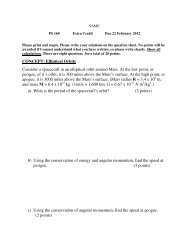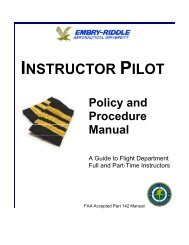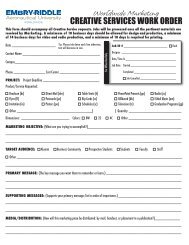checklist - ERAU ETA - Embry-Riddle Aeronautical University
checklist - ERAU ETA - Embry-Riddle Aeronautical University
checklist - ERAU ETA - Embry-Riddle Aeronautical University
You also want an ePaper? Increase the reach of your titles
YUMPU automatically turns print PDFs into web optimized ePapers that Google loves.
98 PA-28R-201 SOP<br />
INTRODUCTION<br />
Successful handling of emergency situations is largely dependent on the<br />
judgment and skill of the flight crew. All emergency conditions should be<br />
handled with planning and organization. Although it is not possible to write<br />
specific procedures to cover every facet of every emergency or irregularity<br />
a pilot may confront, it is possible to establish certain operating guidelines.<br />
The overriding matter of importance is very basic: someone must fly the<br />
airplane. In addition to executing the required procedure(s), the pilot must<br />
still devote primary attention to the control and navigation of the airplane<br />
with regard to terrain, weather, air traffic control, and airplane configuration.<br />
There are some situations which always require a landing at the nearest<br />
suitable airport. These situations include, but are not limited to, cabin<br />
smoke or fire that persists, loss of equipment cooling, and electrical faults<br />
that result in only leaving a single critical system remaining. In any event, it<br />
is the responsibility of the pilot in command to assess the situation and<br />
execute sound judgment to determine the safest course of action to be<br />
taken. It is stressed that for persistent smoke, or a fire that cannot be<br />
positively confirmed to be completely extinguished, the earliest possible<br />
descent, landing, and passenger evacuation should be accomplished.<br />
Cycling or resetting “tripped” circuit breakers shall not be done<br />
indiscriminately. Cycling or resetting circuit breakers on the ground is<br />
acceptable, except for those prohibited in any procedure. Before cycling or<br />
resetting a circuit breaker in flight, the pilot in command shall consider<br />
available resources such as the Pilot’s Operating Handbook (POH), the<br />
<strong>ERAU</strong> Fleet Maintenance Department, and pilot experience to ensure that<br />
no restriction(s) exist.<br />
A tripped circuit breaker may be reset one time after a 90-second cooling<br />
period. Consider the relative importance of the inoperative component to<br />
the remainder of the flight, as well as other indications (i.e., other tripped<br />
circuit breakers, etc.) prior to resetting the associated circuit breaker.<br />
Revised 07-01-2012 © <strong>Embry</strong>-<strong>Riddle</strong> <strong>Aeronautical</strong> <strong>University</strong> Rev 06

















